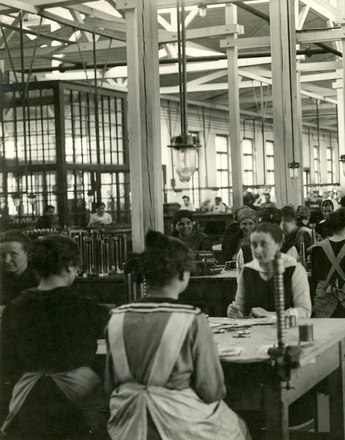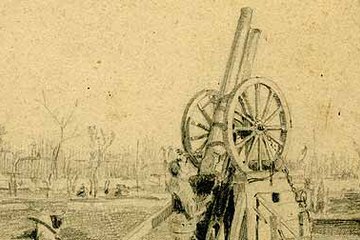Like in other areas of the arms industry there had also been significant innovations since the second half of the 19th century in the fields of explosives and blowing agents ('powders'): this concerned mainly synthetic explosives which around the turn of the century by and large superseded the hitherto common gunpowder.
Concerning propellant powders, i.e. explosives used to fire off missiles, it was the gun cotton (nitrocellulose) which Christian F. Schönbein (1799-1868) discovered in 1846 that started off further developments. However, after Schönbein's discovery it took a good many years before this chemically still instable compound was modified in such a way that it could be practically applied as smokeless nitrocellulose powder. In the mid-1880s the hitherto used gun powder was superseded by a propellant powder based on nitrocellulose. There were many advantages with the new powders: its superior ballistic properties and its more or less residue-free burning qualities. As opposed to gun powder, which released great quantities of salt compounds, the new powders hardly soiled the rifle barrels at all. Also, the low smoke emission was of great advantage as in battle the position of the riflemen could not be detected so easily.
In 1847, one year after Schönbein's discovery of nitrocellulose, the Italian chemist Ascanio Sobrero (1812-1888) developed the explosive nitro-glycerine. It surpassed the hitherto used gun powder with its much higher explosive effect. Still, it took some time before this highly controversial compound found its practical and military application. In particular nitro-glycerine was problematic with its sensitivity towards even the most minor concussions and slightly raised temperatures which could lead to immediate detonation. This was changed in 1866 when the Swedish chemist Alfred Nobel (1833-1896) managed to turn this precarious explosive into something more manageable: by inserting the oleaginous nitro-glycerine into the porous sedimentary rock diatomite Nobel had invented 'dynamite' which he patented a year later.
Further discoveries were made in the field of controversial explosives. There were several explosives in use since the turn of the century that were of military importance: ammonal, trinitrophenol (TNP), also known as picric acid and trinitrotoluene (TNT). These substances replaced the established 'dynamite' that had been in use for military purposes and were the most widely used during the First World War.
With the start of the war the Imperial Army was to change over from ammonal and TNP to TNT, which was easier to process, less sensitive and therefore easier to handle. However, the majority of the high explosive and artillery shells that were produced in the Austro-Hungarian Empire were still filled with ammonal and 'ekrasit' (TNP) which was mainly based on TNP, as the Habsburg chemical industry was not properly prepared for the change. And also the more economical gun powder, which was easier to produce, was still used for military purposes. In the artillery munition of shrapnel it would propel the metal bullets that were moulded into hollow projectiles in the direction of enemy lines.
Klapötke, Thomas M.: Chemie der hochenergetischen Materialien, Berlin 2009
Ortner, M. Christian: Die österreichisch-ungarische Artillerie von 1867 bis 1918. Technik, Organisation, Kampfverfahren, Wien 2007
Rosner, Robert W.: Chemie in Österreich 1740-1914. Lehre, Forschung, Industrie, Wien 2004
-
Chapters
- Explosive Discoveries. From Gunpowder to TNT
- From the Lorenz Gun of Königgrätz to the Ordnance Weapon M1895
- Artillery I.: Technical Innovation and late Modernisation
- Artillery II: The Creeping Barrage, Barrage and Curtain Fire
- The high rate of fire of the machine gun: concerning the Mitrailleuse, the Gatling Gun, the Maxim Gun and the Schwarzlose MG
- An Effective Addition: Hand Grenades and Mortars
- The Imperial Arms Industry




